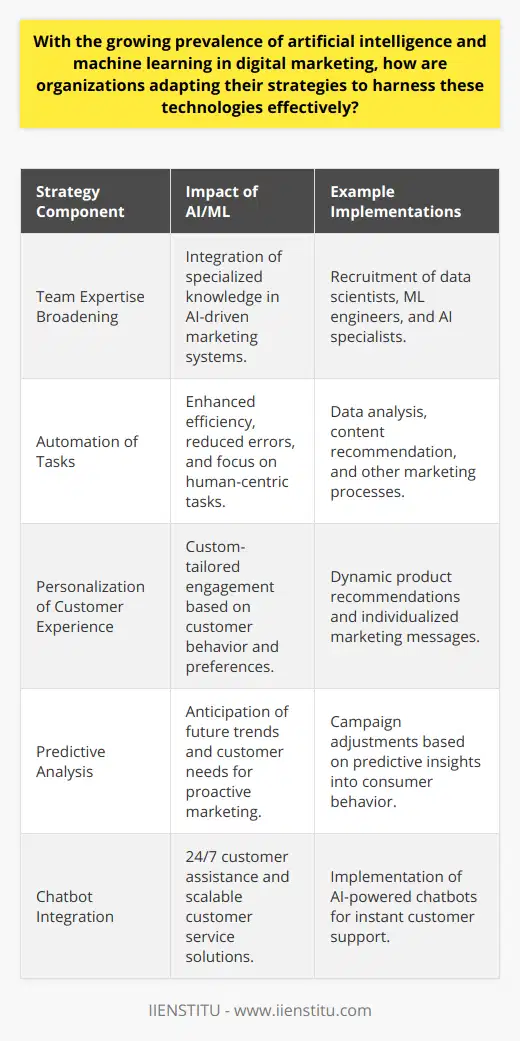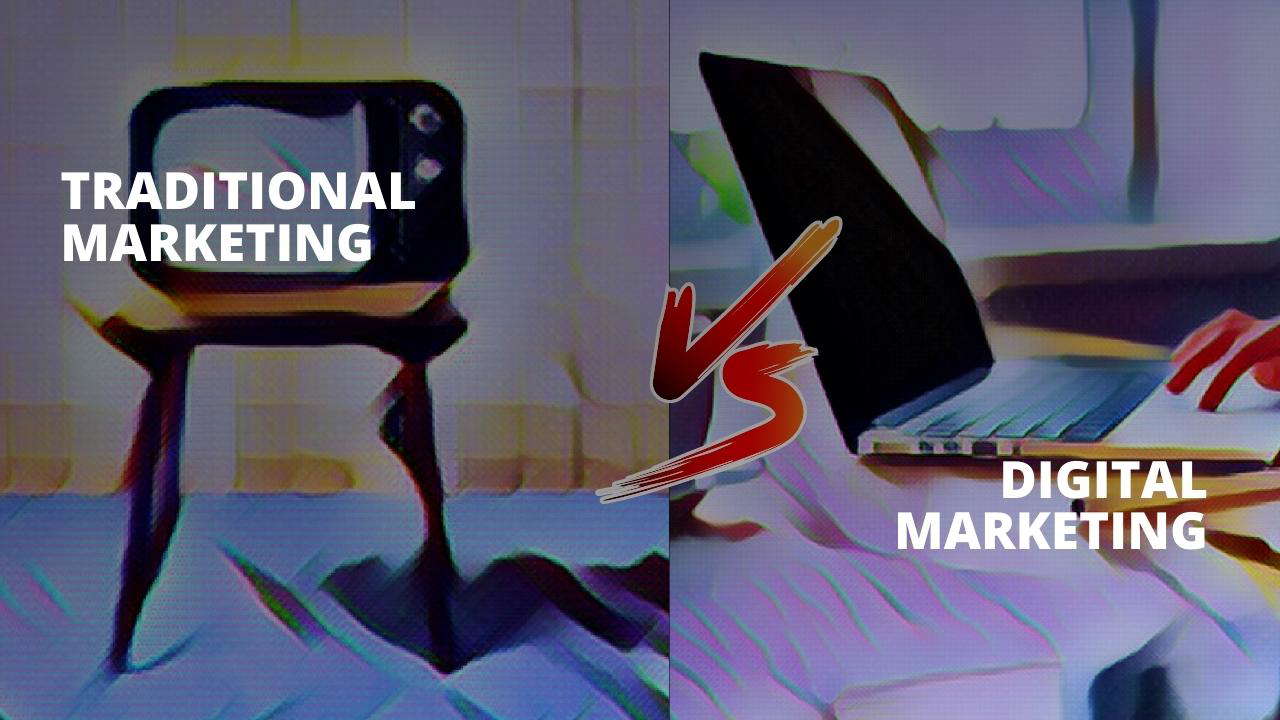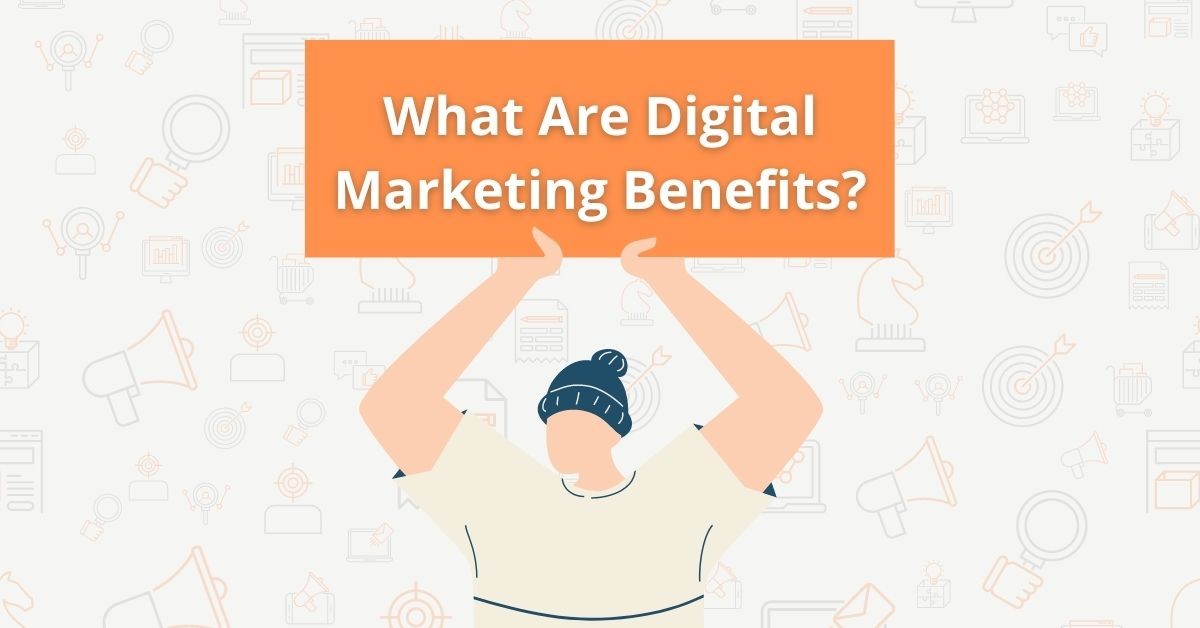
Digital marketing is an umbrella term for all of your online marketing efforts. It includes email marketing, search engine optimization (SEO), social media marketing, and more. When it comes to digital marketing, there are so many options available to you that it can be hard to know where to start. That's why we're here to help!
Related Course: Digital Marketing Course Online
A clear understanding of what you are looking for in an advertisement will help shape and optimize the message, which can be tailored specifically towards potential customers who have already shown interest or need from other advertisements across different channels such as social media platforms like Facebook Advertising with targeting options based on user behavior profiles that show where their interests lie - something called "interest-based' advertising; Google AdWords (you don't even have spam accounts!) etc., search engines, or other websites.
In this blog, we'll teach you the basics of digital marketing and how you can use it to grow your business. We'll cover things like creating a marketing plan, choosing the right channels, and measuring your results.
By the end of this blog, you'll understand how user behavior profiles are created alongside your company's marketing efforts. You will be able to create a clear picture of what works best for your company by using these techniques along with an understanding of social media trends. You will also learn about keywords and how important they are when it comes to SEO.
What Is Digital Marketing Used For?
Digital marketing can be done by using social media, email campaigns, and SEO. Digital marketing is a great way to get your message out there. You can use social media, email campaigns, or search engine optimization (SEO) to do this. Each one has its own benefits, so it's important to choose the right method for your needs.
Social media is a great way to connect with customers and get feedback. You can use it to post new articles or coupons, and encourage customers to share them with their friends. This gives you the chance to interact with people who may not already know your company's name, as well as keep current customers up-to-date on promotions!
Email campaigns are another great way of reaching out. Businesses can use email to send new articles, announcements, or even coupons. You can also use email to track how many people open and click through your links. This can help you determine which content is most popular with your audience. Finally, SEO is a great way to get your site ranked higher in search engine results pages. This means that more people will be able to find you. You can either use SEO on your website, or pay a company to optimize your ads on other sites.
How Can I Decide Which Digital Marketing Methods?
When deciding which method(s) is best for your business, it's important to consider what you want out of each one. Social media allows you to interact with customers and get feedback from them, while email campaigns let you track how well your content is performing. SEO can help you get more traffic to your site, so you can increase sales. Choose the method that will work best for you and your business!
Digital marketing is a great way to connect with customers and get feedback from them, while email campaigns let you track how well your content is performing. This can help you determine what content your audience wants to see more of, so you can create more of it! Need help getting started? You can enroll now for the free digital marketing course at IIENSTITU!
How Can I Use Digital Marketing to Social Media?
The most popular social media sites are Facebook, Twitter, and Instagram. Utilizing these platforms will help you reach a larger audience than just one platform alone.
Social media allows businesses access not only customer data but also their friends' opinions about products which may influence purchase decisions in some cases. For example if there's an advertisement showing up alongside articles related directly to the product being sold by company A would have higher click through rates than Company B.
For example, if you're a small business owner, Facebook can help you reach your target market with laser precision. Twitter is great for real-time engagement and promoting short snippets of content, while Instagram can be used to show off your company's culture, products and services. No matter what your goal is, there's a social media site out there to fit your needs.
The most popular social media sites are Facebook, Twitter, and Instagram. Utilizing these platforms will help you reach a larger audience than just on one site. For example, if you're a small business owner, Facebook can help you reach your target market with laser precision. Twitter is great for real-time engagement and promoting short snippets of content, while Instagram can be used to show off your company's culture, products and services. No matter what your goal is, there's a social media site out there to fit your needs.
Questions about Digital Marketing Advertising
What are effective digital marketing techniques?
Which companies have been successful with their use of modern digital marketing tactics?
What kind of digital marketing ad ways do you typically use to create your ads?
In your opinion, how would you best advertise a business using the internet as a medium?
Do you think digital marketing ads are an effective strategy for modern marketers when advertising businesses on the internet?

Frequently Asked Questions
How is digital marketing changing the landscape of traditional advertising channels?
The Emergence of Digital Platforms
Digital marketing has fundamentally transformed the landscape of traditional advertising channels by introducing a variety of digital platforms. Such platforms include social media networks, search engines, email marketing, and mobile applications. These digital channels have provided new ways for marketers to reach their target audience, boosting the effectiveness of advertising campaigns.
Targeting and Personalization
One of the most significant changes brought about by digital marketing is the increasing focus on targeting and personalization. Previously, traditional advertising channels such as print, radio, and television relied on mass communication to reach a broad audience. In contrast, digital marketing facilitates targeted advertising, enabling businesses to tailor their message to specific segments of their target market. This level of personalization has resulted in improved campaign performance and increased customer engagement.
Data-Driven Decision Making
Another key change is the shift towards data-driven decision making in advertising. Digital marketing has provided marketers with access to a wealth of data on consumer behavior, preferences, demographics, and more. This data allows businesses to make informed decisions regarding their advertising strategy, refining their approach based on actual consumer responses. This transition to data-driven decision making has led to a greater focus on marketing analytics and an emphasis on return on investment (ROI).
Cost Efficiency and Flexibility
The rise of digital marketing has also introduced cost efficiency and flexibility to the advertising landscape. Traditional advertising platforms often required substantial investment, posing barriers to entry for smaller businesses. Conversely, many digital marketing channels, such as social media advertising, offer pay-per-click or pay-per-impression models, reducing upfront costs and providing greater control over budgets. Additionally, digital marketing campaigns can be easily adjusted or halted, granting businesses more flexibility in their advertising strategies.
Integration and Multi-Channel Strategies
Lastly, the growth of digital marketing has necessitated the adoption of integrated multi-channel advertising strategies. As consumers engage with brands across a variety of platforms, advertisers must deliver a cohesive and consistent message. By combining traditional and digital advertising channels, businesses can create a seamless brand experience, fostering stronger customer relationships and driving brand loyalty.
In conclusion, digital marketing has revolutionized the landscape of traditional advertising channels by offering new platforms, enabling targeted and personalized communication, promoting data-driven decision-making, presenting cost efficiency and flexibility, and encouraging integrated multi-channel strategies. As a result, businesses must adapt to this evolving landscape to remain competitive and harness the full potential of modern advertising.

What are the key components and strategies to consider in optimizing digital advertising campaigns?
Key Components for Optimization
To effectively optimize digital advertising campaigns, it is crucial to identify and understand the key components involved. Primarily, these include target audience, ad creative, channels, and performance metrics.
Target Audience
Defining the target audience is paramount to any campaign, as it allows the accurate tailoring of content and communication. Market segmentation, demographics, and psychographics assist in identifying the ideal consumers to engage with the campaign. A clear understanding of the target population helps in creating resonant and relevant advertisements that elicit desired responses.
Ad Creative
The ad creative is essential for capturing the target audience's attention and promoting brand recognition. Careful consideration must be given to factors such as design, messaging, and calls to action. Advertisements must be visually appealing, convey the intended message succinctly, and inspire consumers to take the desired action like visiting a website or making a purchase.
Channels and Platforms
Selecting the appropriate channels and platforms ensures the effective reach of the target audience. These may include search engines, social media sites, and content platforms like blogs and online publications. Each platform has its unique features and requirements that warrant consideration, such as display ad formats, targeting capabilities, and costs. It is critical to diversify and test multiple channels to ascertain which yield the best results.
Performance Metrics
Monitoring and analyzing performance metrics inform critical decisions to optimize campaigns. Key performance indicators (KPIs) reveal the effectiveness of specific tactics as well as the overall campaign. Examples of KPIs include impressions, click-through rates (CTR), conversion rates, and return on investment (ROI). Regular tracking and adjustments based on these metrics improve advertising efforts.
Strategies for Optimization
Successful optimization necessitates the development and implementation of various strategies. Among these are A/B testing, data-driven insights, and appropriate resource allocation.
A/B Testing
A/B testing, also known as split testing, involves comparing the performance of different ad creative variants or targeting options. By systematically evaluating various ad elements, marketers can deduce the most effective strategies and refine their campaigns accordingly.
Data-Driven Insights
Campaign optimization relies on data-driven insights, which include analysis of campaign metrics as well as audience behavior and preferences. By harnessing and interpreting data, marketers can make well-informed decisions to improve the efficacy of their digital campaigns.
Resource Allocation
Lastly, smart resource allocation ensures that investments are directed towards the most effective channels and creatives. By continually monitoring and assessing the performance of various campaign elements, marketers can adjust budgets and focus to maximize return on investment.
In conclusion, optimizing digital advertising campaigns entails a deep understanding of the key components and strategic methodologies that drive effective engagement. By considering aspects like target audience, ad creative, channels, and performance metrics, alongside strategies such as A/B testing and data-driven insights, marketers can bolster the positive outcomes of their campaigns.
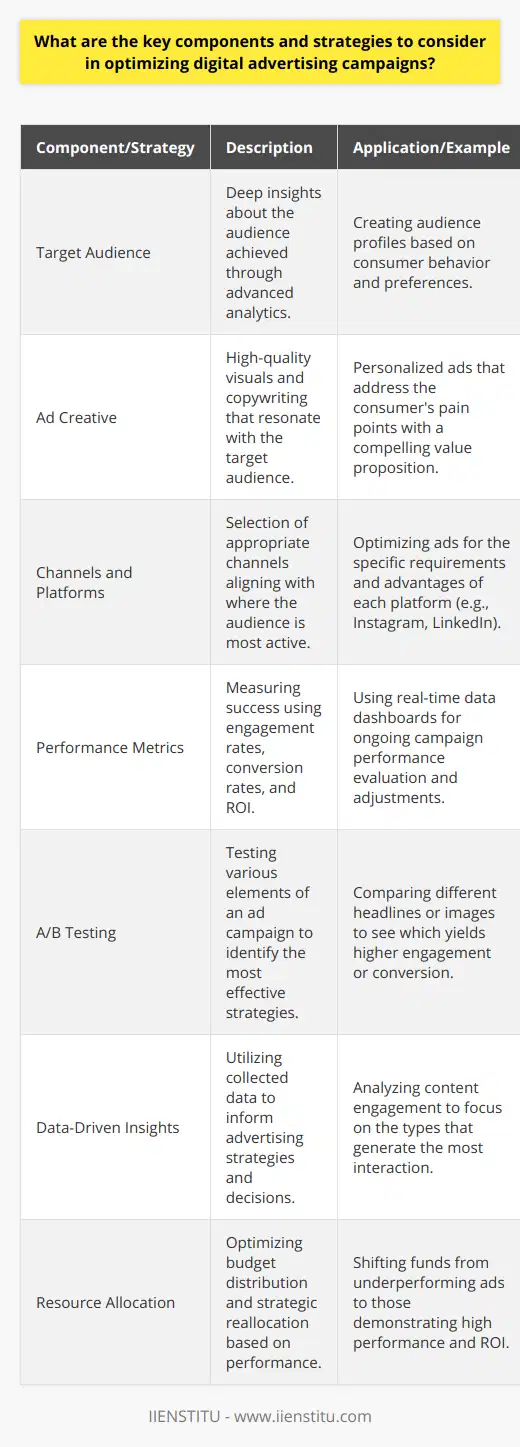
How has the importance of digital advertising evolved over time in relation to consumer behavior and market trends?
Evolution of Digital Advertising
The importance of digital advertising has significantly evolved over time, driven by changes in consumer behavior and market trends. In the early stages of the internet, digital ads primarily consisted of banner ads and email campaigns, targeting a smaller audience who had access to online resources. However, with the rapid rise in internet penetration, digital advertising became a necessity for businesses seeking to tap into the ever-growing user base.
Increasing Role of Social Media
The advent of social media platforms transformed digital advertising as interactions between businesses and consumers became more direct and personalized. Social media ads, influencer marketing, and native advertising enabled brands to create genuine connections with their target audience. These channels allowed for better engagement and superior targeting capabilities, making digital advertising more effective than traditional methods.
Shift Towards Mobile Engagement
The proliferation of smartphones and mobile devices precipitated another shift in digital advertising. Marketers capitalized on the ubiquity of mobile devices, tailoring ad experiences for smaller screens and on-the-go consumption. Mobile advertising gave rise to location-based marketing and app-based campaigns, adding another layer of relevance and personalization that is crucial in driving consumer engagement.
Data-Driven Marketing Strategies
In the age of big data, digital advertising has become indispensable for businesses seeking to better understand and cater to their audience. The ability to collect, analyze, and utilize consumer data has led to sophisticated ad targeting, enabling precise delivery of messages to the right individuals at the right time. Data-driven strategies have improved advertising ROI, making digital advertising a vital component of comprehensive marketing campaigns.
Emphasis on Privacy and Consent
Recent years have seen growing concerns around data privacy and the responsible use of consumer information in digital advertising. As a response, regulations like the General Data Protection Regulation (GDPR) have come into effect, emphasizing the importance of obtaining user consent and ensuring transparency. Advertisers have had to adapt their strategies accordingly, focusing on building trust with consumers and prioritizing privacy.
In conclusion, the evolution of digital advertising is a continuous process influenced by technological advancements, market trends, and consumer behavior. As these factors change, digital advertising continues to adapt and remain a critical tool for businesses looking to connect with their target audience and achieve their marketing goals.

How is digital marketing used today to effectively target specific consumer demographics?
Understanding Digital Marketing Methods
Digital marketing has evolved tremendously in recent years, and businesses have been leveraging its power to target specific consumer demographics effectively. Utilizing the vast array of data available online, marketers craft strategies that engage and inform potential consumers by deploying techniques such as content marketing, social media advertising, and search engine optimization.
Crafting Personalized Content
The foundation of impactful digital marketing lies in creating personalized content for different consumer demographics. In content marketing, companies generate relevant and engaging articles, infographics, videos, and other media, designed to inform and entertain their target audience. This content addresses specific consumer needs and preferences, resulting in a stronger emotional connection with the brand and improved brand recall.
Harnessing Social Media Advertising
Social media platforms offer invaluable tools for targeting specific demographics. With detailed user data at their disposal, marketers can develop advertising campaigns tailored to specific age groups, genders, locations, and interests. By leveraging these insights, businesses create ads that resonate with their target audience, fostering brand loyalty and driving conversions. Platform algorithms further enhance this targeting by delivering ads to users who are likely to engage with them based on their online interactions and behaviors.
Optimizing Websites for Search Engines
Search engine optimization (SEO) is another essential aspect of digital marketing for connecting with target demographics. By optimizing websites for specific keywords and search terms, businesses can rank higher on search engine results pages (SERPs) for their relevant offerings. SEO success not only increases organic traffic but also enables companies to connect with consumers who are already searching for their products or services, thus improving conversion rates.
Utilizing Email Marketing Campaigns
Email marketing remains a valuable tool in targeting specific consumer demographics. By segmenting email lists based on demographic data, marketers can create tailored email campaigns based on subscribers' interests, behaviors, and preferences. Such personalized emails lead to higher open and click-through rates and ultimately increased conversions.
Benefiting from Influencer Partnerships
Influencer marketing has become a powerful component of digital marketing strategies, as brands partner with influencers who boast specific demographic followings. By aligning their products or services with an influencer whose audience mirrors their target demographic, businesses reach and engage potential consumers in a highly authentic and effective manner.
In conclusion, digital marketing presents numerous opportunities for businesses to target specific consumer demographics through innovative methods such as personalized content creation, social media advertising, search engine optimization, segmented email campaigns, and influencer partnerships. These approaches empower marketers to create highly relevant and engaging experiences for their target audience, ultimately driving improved brand recognition, loyalty, and conversion rates.
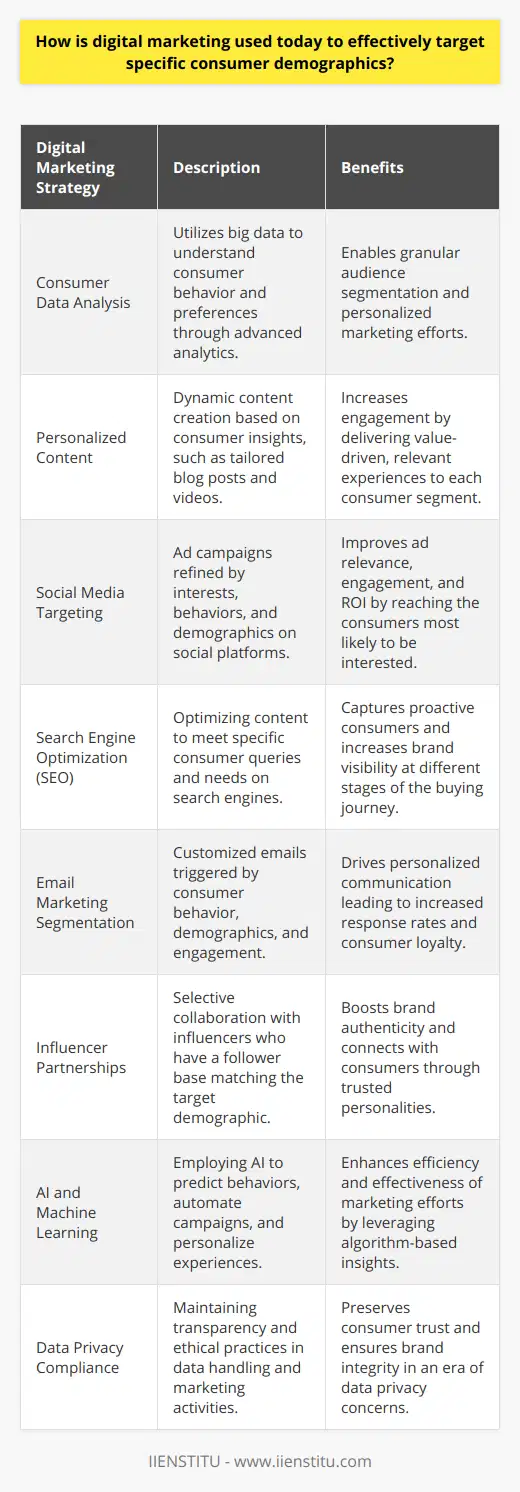
In what ways has the advent of digital marketing provided new opportunities for small businesses and niche markets?
Expanding Market Reach
The advent of digital marketing has revolutionized the business landscape for small businesses and niche markets by significantly expanding their market reach. Previously, these businesses faced challenges in marketing their products or services to a widespread audience due to geographic limitations and budget constraints. With the growth of the internet and social media platforms, they can now reach potential customers worldwide.
Cost-effective Marketing Strategies
Digital marketing provides cost-effective solutions compared to traditional marketing methods such as newspaper advertisements, billboards, and television commercials. Small businesses can leverage affordable strategies like search engine optimization, email marketing, and social media marketing to generate greater visibility for their products and services. This enables niche markets to maximize their marketing budgets while achieving a broader consumer base.
Targeted and Personalized Marketing
Digital marketing facilitates targeted and personalized communication with audiences, enabling small businesses and niche markets to tailor their marketing efforts. With access to consumer data and analytics, businesses can create customer segments based on factors such as demographics, interests, and online behavior. This targeted approach ensures that marketing efforts resonate with the intended audience, leading to higher conversion rates and returns on investment.
Versatility and Adaptability
The dynamic nature of digital marketing allows businesses to utilize versatile and adaptable strategies suitable for their unique needs. Small businesses can experiment with various marketing channels, such as content marketing, pay-per-click advertising, and influencer collaborations, to identify the ones that yield the best results. Additionally, monitoring and analyzing digital marketing campaigns allow businesses to make adjustments quickly, ensuring continued growth and success.
Enhanced Customer Engagement
The interactive nature of digital marketing platforms fosters enhanced customer engagement, which is vital for building long-lasting relationships. Small businesses and niche markets can communicate directly with their customers and respond promptly to inquiries, complaints, or feedback. Through social media platforms, businesses can create a community where customers feel a sense of belonging and loyalty.
In conclusion, the advent of digital marketing has opened up new opportunities for small businesses and niche markets to experience significant growth. Through cost-effective marketing strategies, targeted and personalized communication, versatility, adaptability, and enhanced customer engagement, these businesses are now equipped to compete effectively in the global marketplace.
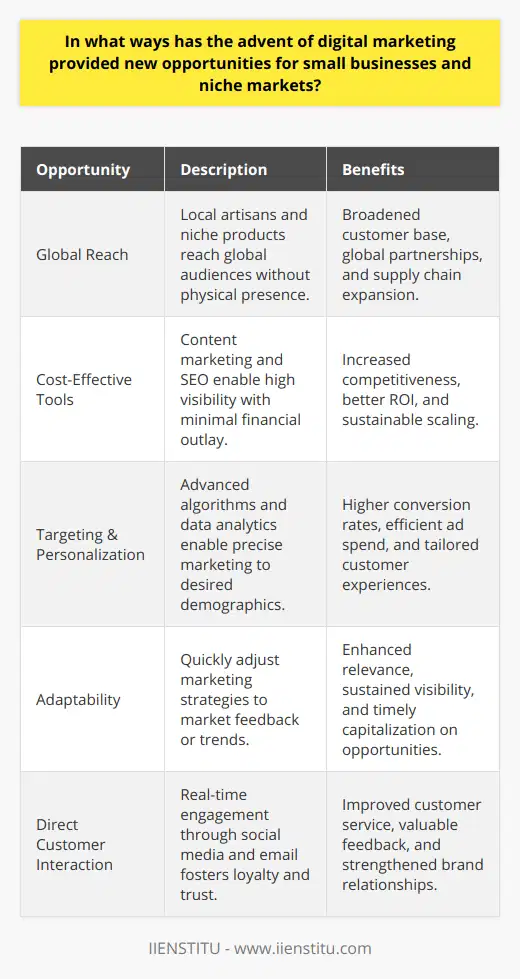
What are the most significant challenges faced by marketers in keeping pace with the rapid advancements in digital marketing technology?
Challenges in Adapting to Digital Marketing Advancements
Rapid Technological Changes
One of the most significant challenges faced by marketers is adapting to the constant advancements in digital marketing technology. The rapid pace of change requires continuous learning and the ability to be agile in the face of evolving platforms and techniques.
Developing Personalized Content
Another challenge is the development of personalized content to effectively engage target audiences. Marketers must analyze consumer data and utilize advanced algorithms to cater to individual preferences, increasing the complexity of campaign strategies.
Data Privacy and Security Concerns
Data privacy and security have become critical issues for marketers due to increasing regulatory requirements and a growing concern for consumer privacy. Navigating these concerns while maintaining effective digital marketing campaigns presents a substantial challenge.
Skills and Talent Acquisition
Finding and retaining the right talent with the necessary skills to stay competitive in a rapidly evolving industry can be difficult for marketers. Companies must invest in continuous learning and development opportunities for their teams to keep pace with the changing landscape of digital marketing technology.
Integrating Multiple Channels
Integration of various channels and platforms is yet another challenge marketers face. The increasing number of digital channels available to businesses requires seamless integration for a coherent and effective customer experience.
Adapting to New Formats
Adapting to new formats, such as voice search, augmented and virtual reality, or the rise of influencer and video marketing, can pose significant challenges for marketers. These new trends demand innovative approaches and the ability to diversify beyond traditional marketing strategies.
Measuring Campaign Effectiveness
Lastly, measuring the effectiveness of digital marketing efforts is complex due to the multiple channels and touchpoints involved in modern campaigns. Marketers need to refine their analytical skills and utilize advanced metrics to accurately assess the success of their strategies in this ever-evolving landscape.

What is the role of data-driven insights and analytics in shaping digital marketing strategies today?
Data-driven Insights and the Marketing Landscape
In today's digital age, data-driven insights play a crucial role in structuring online marketing strategies. They provide unparalleled understanding of customer behavior, drives targeted marketing and enhance customer relationships.
Understanding Customer Behaviour
Firstly, the analysis of customer data reveals behavioural patterns, enabling marketers to precisely pinpoint their target audience. For instance, insights may reveal that a certain demographic responds most strongly to a specific type of content.
Strategy in Targeted Marketing
Data-driven insight also allows for a higher degree of specificity in targeted marketing. By analyzing purchase histories and user interactions, businesses can predict what a customer might want even before they know it themselves. This focuses marketing efforts, helping to ensure they reach the right people at the right time.
Strengthening Customer Relationships
Additionally, data-driven insights build and enhance customer relationships. Understanding customer habits, preferences and dislikes aids in creating personalized content. This not only increases customer satisfaction but also fosters loyalty and encourages repeat business.
A Better ROI
Importantly, data-driven approaches help prove return on investment (ROI). Incorporating analytics into digital marketing strategies allows businesses to track how their campaigns are performing. It enables them to modify their tactics, ensuring they get the most value from their marketing budget.
In conclusion, the meticulous use of data-driven insights revolutionizes digital marketing by allowing for sharper focus, smarter strategies, deeper customer understanding, and an improved ROI. Today, these insights lie at the heart of any successful digital marketing strategy.
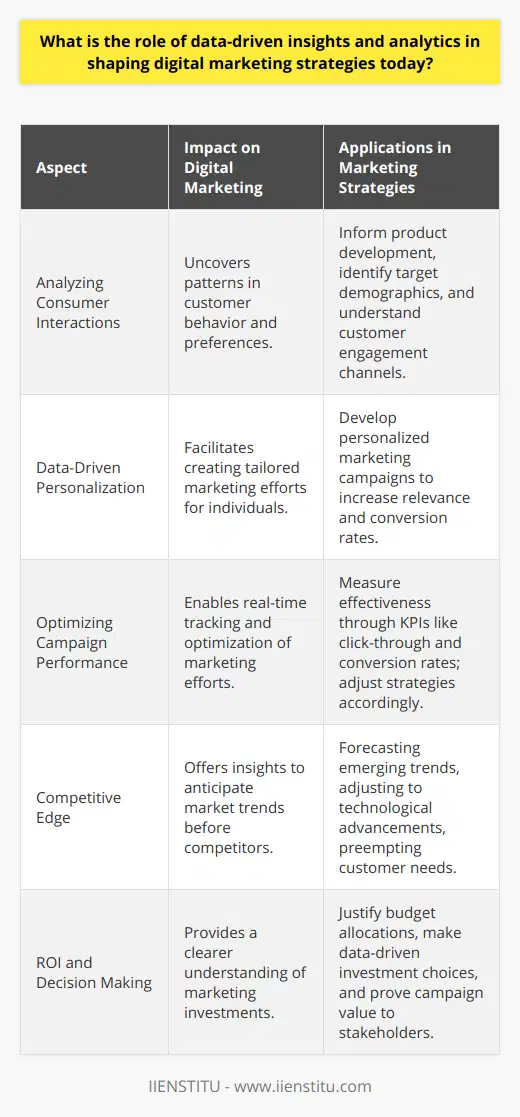
How can digital marketing personalization contribute to achieving better customer engagement and loyalty in today's competitive market?
Digital Marketing Personalization
Digital marketing personalization allows companies to create customized experiences tailored to individual customer preferences. It captures a customer's attention and keeps them engaged with personalized content, products, or services, fostering deeper customer engagement. This deepened engagement often translates into improved customer loyalty.
Understanding Customers' Needs and Preferences
Knowing customers’ needs and preferences strengthens the bond of trust with them. Personalized digital marketing involves leveraging customer data to understand their behaviors, preferences, and past purchase history. The gathered data guide in tailoring your marketing efforts per your customers' individual needs, leading to better engagement.
Improved Customer Experience
When marketing efforts resonate with customers' personal needs, they feel understood and valued. They enjoy improved experiences resulting from the relevance of messages to their unique preferences. Thus, personalization gives customers a sense of importance, which promotes satisfaction and ultimately loyalty.
Building Trust and Loyalty
In the competitive market, loyalty can only be achieved by exceeding customer expectations and delivering value constantly. Personalized digital content is a game-changer that shifts the focus from mass selling to individual-focused selling. Maintaining consistent personalization progressively builds trust and brand loyalty.
Effective Communication
Personalization in digital marketing offers targeted and meaningful communication, drawing customers closer. This specificity impacts the customer’s perception improves their engagement and loyalty. They appreciate promotions tailored to their interests and that are relevant to their needs. This way, seemingly promotional content does not look like overt advertising, but rather valuable pieces of information to the consumer.
In a nutshell, digital marketing personalization contributes to better customer engagement and loyalty by understanding individuals' unique preferences, improving their experiences, building trust, and facilitating effective communication. This strategy could be an essential tool for businesses looking to thrive in today's competitive market.

With the increasing focus on sustainability and social responsibility in marketing, how are organizations leveraging digital marketing to communicate their values and foster meaningful connections with their audience?
Digital Marketing and Sustainability Communication
Businesses are harnessing digital marketing strategies to communicate their commitment to sustainability and social responsibility. Digital platforms provide an immediate and direct link to consumers, fostering dialogue and engagement.
Utilizing Social Media Platforms
Social media platforms are one effective method. They help organizations to share sustainability goals, progress reports, and initiatives in an easily digestible format. This transparency builds consumer trust.
Content Marketing for Value Communication
Content marketing is another key tool. Companies create high-quality written, visual, or video content centered around their ecofriendly values. This content not only informs audiences but also tells a compelling story about their sustainable journey.
Interactive Experiences for Audience Connection
Furthermore, some businesses design interactive digital experiences. These allow consumers to engage more deeply with the brand’s sustainability practices. For instance, virtual tours of eco-friendly facilities or interactive sustainability reports can create a memorable connection.
Online Influencers and Sustainability Partnerships
Collaboration with online influencers who resonate with organizational values is also becoming prominent. These partnerships can amplify the reach of the brand’s sustainability messaging to a wider, more targeted audience.
Personalized Sustainability Communication
Finally, digital marketing lets organizations personalize their sustainability communication, tailoring messages to individual consumers based on preference and behavior. This customization enhances relevance, fostering a stronger emotional connection with the brand, and its values.
In conclusion, digital marketing offers diverse tools for communicating sustainability commitments, enabling organizations to create meaningful connections with their consumers. The authentic broadcast of such actions can significantly enhance a brand's reputation, drive consumer loyalty and ultimately, yield a sustainable advantage in the competitive market landscape.

How is digital marketing used today to improve the overall customer experience and journey?
Enhancing the Customer Experience Through Digital Marketing
Digital marketing today plays a fundamental role in improving the customer experience and journey. Brands employ varied strategies to ensure a seamless utilization of digital tools for customer satisfaction.
Understanding Customer Behavior
Notable is the use of analytics in understanding customer behaviour. Firms collect data on customer online activities, establish patterns, and predict customer behaviour. This results in personalized experiences based on individual preferences and browsing history. Marketers can tailor content, offers, and communications, enhancing the customer journey and resulting in higher engagement rates.
Leveraging Social Media
Companies increasingly leverage social media platforms to interact with customers. It allows direct communication, helping businesses understand customer needs and get instant feedback. This fosters a stronger customer-brand relationship, enhancing overall customer experience. Moreover, it paves the way for brand advocacy, where satisfied customers are likely to recommend the brand to others.
Utilization of AI and Chatbots
The incorporation of AI and chatbots in digital marketing has also improved the customer journey significantly. Chatbots provide instant responses to queries, reducing customer wait times. AI’s predictive capabilities offer product recommendations, making the shopping journey more convenient.
Enhancing Mobile Experience
Today, a sizable chunk of consumers access online services via mobile devices. Therefore, businesses are focusing on providing a seamless mobile experience. It includes mobile-optimized websites and apps, which make navigation easier, thereby improving the customer journey.
In conclusion, digital marketing tactics aim at establishing a positive customer experience. The use of analytics, social media, AI and chatbots, and mobile optimization are some of the strategies used by businesses today. These contribute to a personalized and seamless journey for customers, leading to improved satisfaction and brand loyalty.
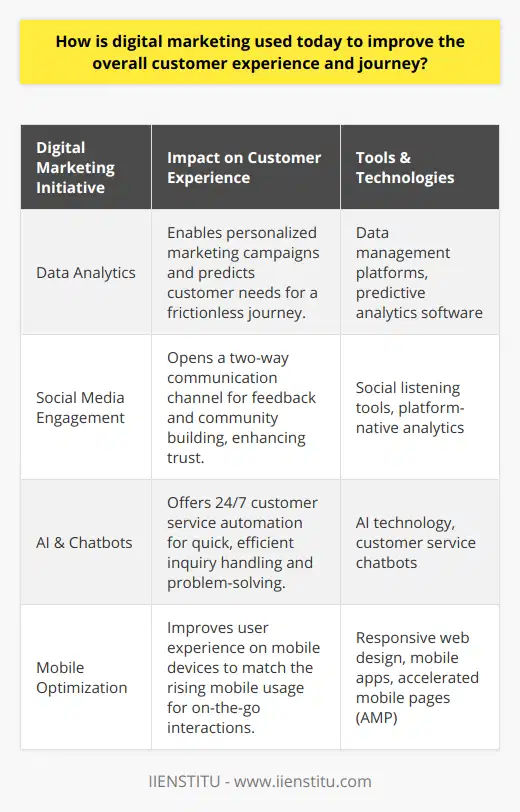
What are the ethical considerations and potential pitfalls that marketers should be mindful of when employing digital marketing tactics?
Ethical Considerations in Digital Marketing
Marketing professionals should consider the ethical dimension of their e-marketing strategies. Firstly, the issue of privacy constitutes a main ethical concern. The unsuspecting customer may not realize that their data is being used without consent. Marketers ought to always notify potential customers on the usage of their data.
Transparent Data Usage
In line with the privacy concern, transparency is critical. Misleading marketing practices, such as hidden fees, false advertising or exaggeration of product benefits can damage the company's reputation. Honesty is paramount in all marketing campaigns to ensure long-term customer relationships.
Respect for Cultural Diversity
Marketers must be aware of cultural sensitivities when crafting their digital marketing campaigns. Failing to respect cultural diversity could lead to offending potential customers. There is a need to respect different beliefs and avoid stereotyping.
Avoiding Information Overload
Another ethical consideration lies in the possible information overload. Bombarding consumers with excessive content could create confusion, leading to poor product understanding. Information ought to be disseminated in a clear and manageable manner.
Potential Pitfalls in Digital Marketing
Several potential pitfalls exist in digital marketing. Firstly, customer trust may be eroded if ethical guidelines are not strictly followed. This has implications for customer retention. Secondly, negative publicity resulting from unethical practices can tarnish the business's brand image. Lastly, non-compliance with legal rules and regulations related to data protection and privacy can result in hefty penalties.
Mitigating Unethical Practices
To prevent pitfalls while reaping the benefits of digital marketing techniques, marketers must uphold legal and ethical norms strictly. They must ensure transparency, respect cultural diversity, avoid information overload, and above all adhere to data privacy laws. Negligence of these points could lead to reputational damage, financial penalties and loss of customer trust. Therefore, ethical considerations remain paramount in digital marketing.
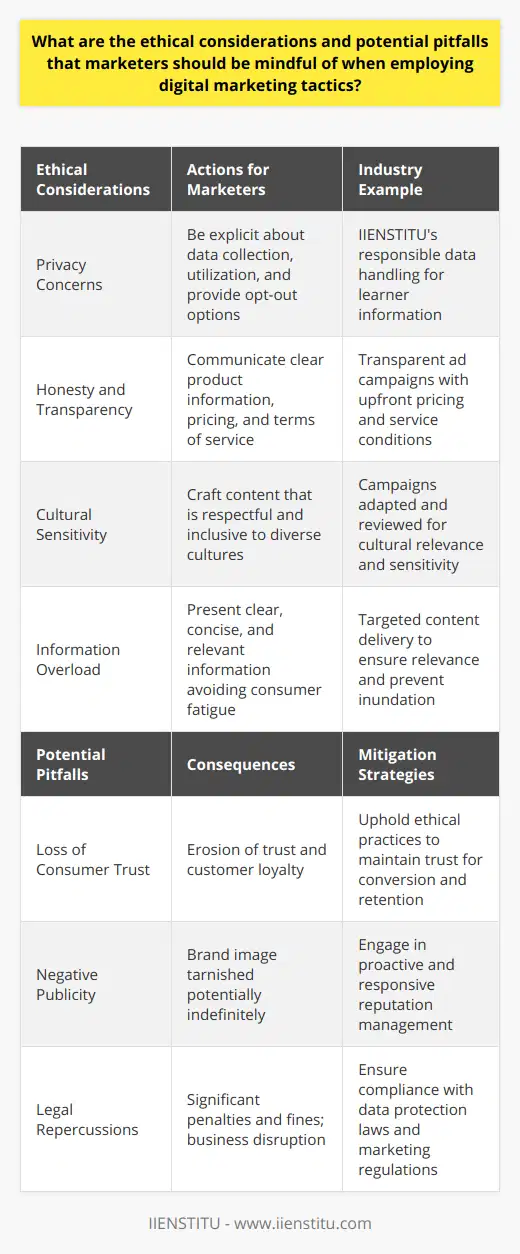
In the context of the ongoing global pandemic, how have digital marketing strategies been adapted to address the changing consumer needs and preferences?
Adapting Digital Marketing Strategies
The global pandemic has necessitated significant shifts in digital marketing strategies to cater to changing consumer needs and preferences. Businesses are making increased use of online platforms for sales and communication. They aim to engage customers increasingly reliant on internet-based solutions due to lockdown measures and social distancing rules.
Increasing Online Presence
Online presence has become more important than ever for businesses. They have responded through bolstering their online marketing and sales channels. Subsequently, many businesses have redesigned their websites or developed new ones. They are aiming to provide a smooth and pleasurable online shopping experience for consumers.
Leveraging Social Media
There has also been increased usage of social media. Businesses are reaching out to consumers through popular platforms like Facebook, Twitter, and Instagram. They keep their audience informed about new products, changes in operations, or response to the pandemic. This strategy provides an avenue for increased interaction and engagement with consumers.
Relying on SEO and Content Marketing
Moreover, search engine optimization (SEO) and content marketing strategies have come to the fore. Producing high-quality, relevant content can improve a business's SEO, making it easier for consumers to find them online. A good SEO strategy assists in promoting products and services to consumers who are spending more time online.
Utilizing Email Marketing
Finally, businesses are making good use of email marketing. They take this opportunity to keep in touch with their customers, informing them about special offers, updates, or changes in services due to the pandemic.
In conclusion, digital marketing strategies have pivoted to accommodate the newfound reliance on online solutions during the pandemic. By leveraging these techniques, businesses can adapt to changing consumer needs and preferences.

What are the current best practices for integrating digital marketing with traditional marketing methods?
Integration of Digital and Traditional Marketing
One of the most significant current practices in integrating digital marketing with traditional modes is developing a consistent brand message across all platforms. Brand consistency enhances recall and recognition, thereby strengthening customer relationships.
Using Data-Driven Strategies
Data-driven strategies are also crucial in integrating these marketing methods. Companies are harnessing data analytics to gain insights, inform decision-making, and enhance customisation of both digital and traditional marketing content.
Implementing Omni-Channel Approach
Adopting an omni-channel approach to promotion ensures that customers have a seamless experience with a brand, irrespective of the platform they opt to use. This practice involves integrating all touchpoints to create a unified customer experience across both offline and online channels.
Leveraging Content Marketing
The effective integration of digital and traditional marketing also heavily leans on content marketing. Delivering engaging and relevant content across multiple channels helps brands stay firmly etched in the mind of customers.
Utilizing Social Media Integration
Integrating social media into traditional marketing methods also tops the list of best practices. Businesses are combining social networks with print, television, and outdoor advertising for wider reach and promotional resonance.
Ensuring Mobile Optimization
Lastly, optimizing traditional marketing for mobile devices is another key practice. Brands are making it easy for customers to transition from offline to online experiences by including QR codes in print ads or providing links to websites or social accounts in television commercials.
In concluding, adopting an integrated approach to digital and traditional marketing is crucial in today's multi-channel consumer climate. By accomplishing brand consistency, implementing data-driven strategies, adopting an omnichannel approach, leveraging content marketing, integrating social media, and ensuring mobile optimization, marketers can create synergistic marketing strategies that drive customer engagement and boost brand value.
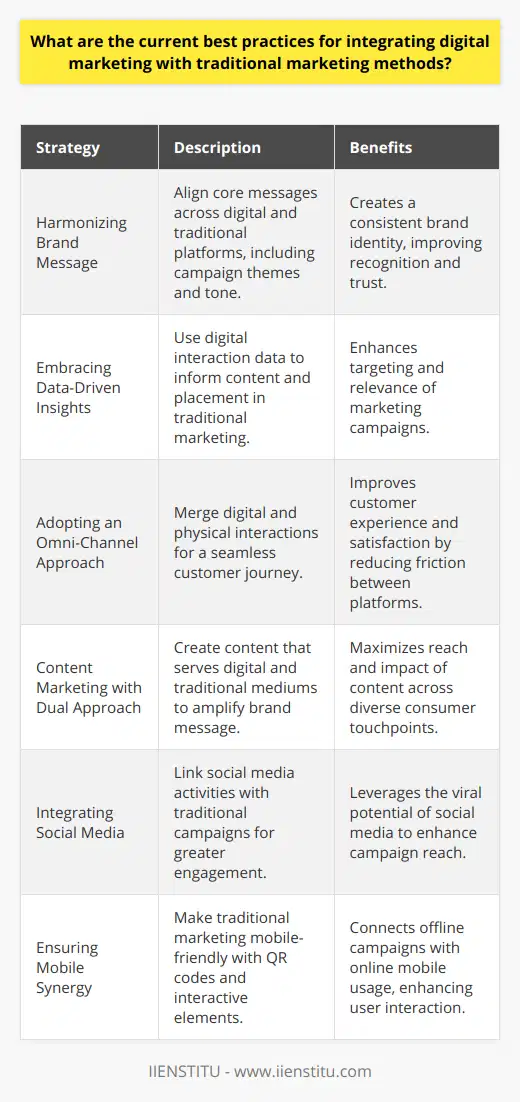
How has the rise of influencer marketing and user-generated content impacted the digital marketing landscape today?
Influencer Marketing: A Game Changer
Influencer marketing has significantly altered the digital marketing landscape. It leverages the power of popular individuals who hold sway over a large audience, primarily on social media platforms. These so-called 'influencers' collaborate with brands, promoting their products or services through a personal endorsement or subtle advertising in their posts.
Increasing Trust Among Consumers
This practice has changed the consumer-brand relationship. Instead of relying solely on traditional advertisements, consumers now trust the personal recommendations of their favorite influencers. This trust enhances brand credibility and loyalty, which in turn leads to higher conversion rates.
Breakthrough in User-Generated Content
Alongside influencer marketing, user-generated content (UGC) has revolutionized digital marketing. These are unpolished, organic materials created and shared by consumers themselves, offering a glimpse into their authentic experiences with a product or service. UGC adds a layer of authenticity and personalization that attracts potential customers, increasing the likelihood of a purchase.
Impact on Brand Awareness and Visibility
UGC not only benefits consumers but also brands. It raises brand awareness and improves search engine optimization (SEO), enhancing digital visibility. More visibility means increased audience engagement, generating more leads and potential conversions.
Synergy Between Influencer Marketing and UGC
Influencer marketing and UGC often work hand in hand. Influencers encourage their followers to interact with brands, leading to more UGC. Simultaneously, UGC elevates influencer credibility, resulting in a potent combination that increases overall marketing effectiveness.
In summary, the rise of influencer marketing and UGC has transformed digital marketing. Their interaction yields mounting consumer trust, brand awareness, and SEO benefits. These developments promise more innovative, effective marketing strategies in the future.

With the growing prevalence of artificial intelligence and machine learning in digital marketing, how are organizations adapting their strategies to harness these technologies effectively?
Adapting Marketing Strategies to AI and ML
Organizations readily adapt their strategies to accommodate AI and ML. Firstly, they diversify their teams. As AI and ML require specialized knowledge, companies increasingly recruit experts in these fields.
Automating Routine Tasks
Secondly, organizations automate routine tasks, thus improving efficiency. For example, AI can automate data analysis, freeing human employees for more creative work. Machine Learning also offers companies the ability to predetermine the success of a digital marketing strategy through simulations.
Personalizing Customer Experience
Thirdly, adaption involves harnessing AI for customer personalization. Customized advertising strategies provide consumers with highly relevant product suggestions. AI can analyze massive amounts of data, identifying individual purchasing preferences and patterns.
Predictive Analysis and Forecasting
Another strategy is investing in predictive analysis and forecasting. AI can map consumer behavior, allowing businesses to anticipate future trends. Forecast accuracy also assists organizations in more efficient budget planning.
Chatbot Implementation
Moreover, businesses are also implementing chatbots on their websites and social media platforms. These AI-powered tools offer 24/7 customer service, instantly responding to customer inquiries and complaints.
In conclusion, by investing in skilled personnel, automating tasks, and utilizing AI for personalization, prediction, and customer service, organizations can effectively adapt to the rise of AI and ML in digital marketing.
